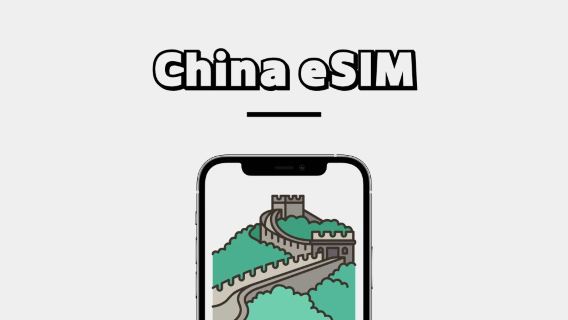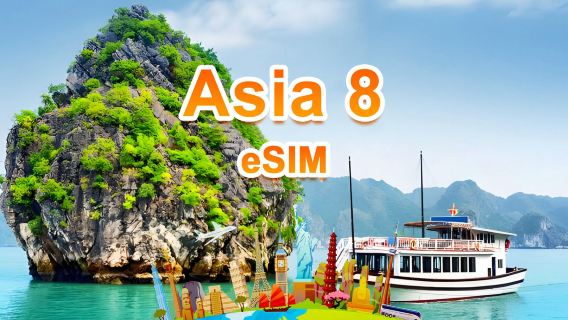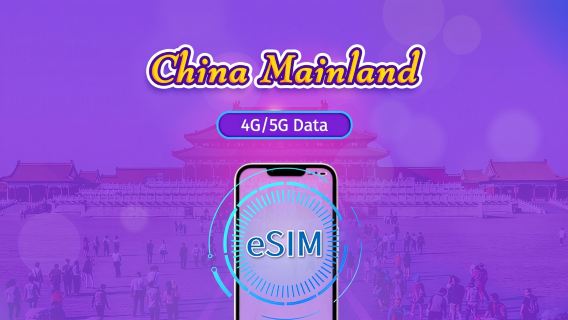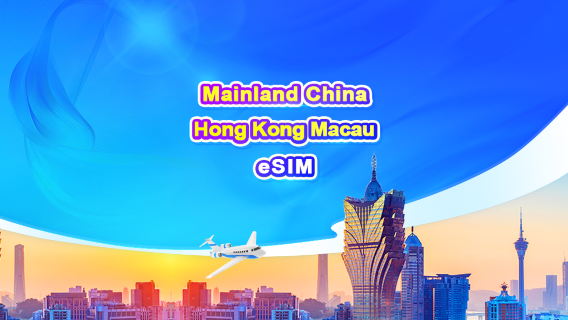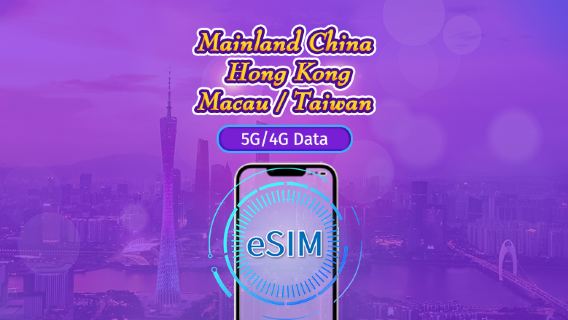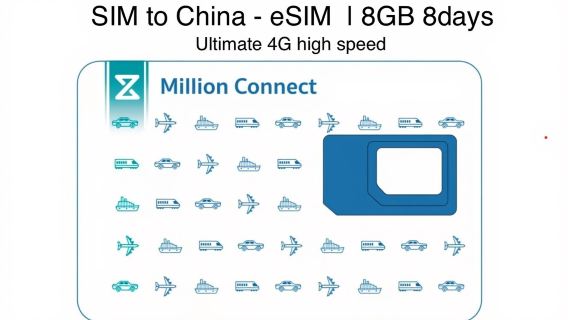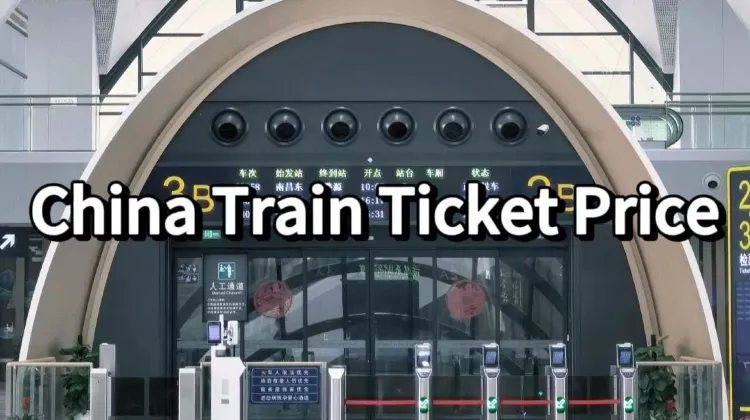
Choosing the right China train ticket is easy with our guide. We explain China train ticket price, different types of train and show them in a clear table format. You'll also find a comparison of first and second class seats on China's high-speed trains. Our guide helps you see the differences so you can pick the best ticket for your trip~😘
🔥Exclusive China Train Coupon: Get 3% OFF Now!
Book your China train tickets as a new user on Trip.com and enjoy a special 3% Off 🎁! Use our exclusive coupon to save big on your first train journey!!!👀
✨Popular China Bullet Train Routes✨
- DepartureShanghai Hongqiao
- ArrivalHangzhou East
- Duration~45m
- Price (2nd Class)From $8.00
- DepartureShanghai Hongqiao
- ArrivalBeijing South
- Duration~6h
- Price (2nd Class)From $79.40
- DepartureShanghai Hongqiao
- ArrivalShenzhen North
- Duration~7h
- Price (2nd Class)From $81.46
【3% Off】Buy China Train Tickets Online
Click to Check China Train Ticket Prices
When considering the choice between First Class and Second Class tickets on China's high-speed trains, the primary factor to consider is price. A First Class ticket typically costs about 1.6 times that of a Second Class ticket. For instance, on the Beijing to Shanghai route, the price of a First Class seat is approximately 1.6533 times that of a Second Class seat.
| From/To | Train Number | Duration | Second Class Price (USD) | First Class Price (USD) | Check More Ticket Price |
| Beijing South to Shanghai Hongqiao | G28 | 4h 18m | $86.49 | $142.99 | |
| Nanjing South to Shanghai Hongqiao | G7349 | 1h 30m | $18.65 | $31.50 | |
| Shenzhen North to Guangzhou South | G1022 | 29m | $10.30 | $13.75 | |
| Shanghai Hongqiao to Xi'an North | G360 | 5h 39m | $100.15 | $160.31 |
From personal experience, if budget is not a concern and you really desire a bit more comfort, First Class might be worth considering as it offers slightly more comfortable seating arrangements. However, I often travel Second Class myself, as the seats are quite comfortable and suitable for journeys within five hours. The comfort level in Second Class is generally sufficient for most travelers, making the extra cost of First Class hard to justify unless the additional comfort is a priority for you.
All in all, the decision between First and Second Class should depend on your personal budget and comfort preferences. The difference in cost may not seem large to some, but for budget-conscious travelers, Second Class offers a very reasonable level of comfort without the higher expense.
✅Explore More in Beijing
✅Explore More in Shanghai
How to Choose China Train Tickets
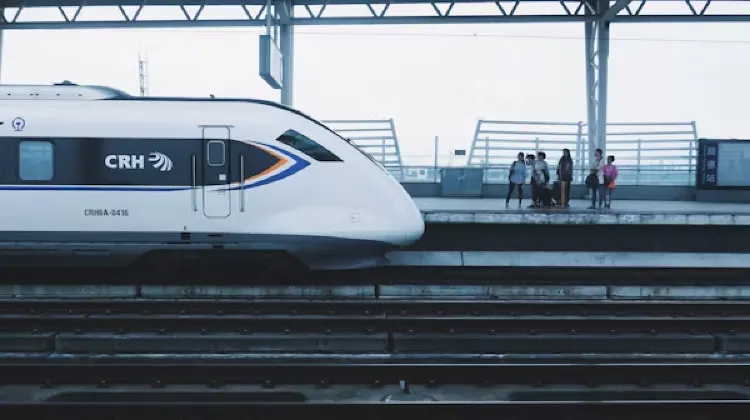
China G-Class Train (Source from: Unsplash)
Different China Train Ticket Types
China's train tickets are divided into 7 classes based on comfort: hard seat, soft seat, second-class seat, first-class seat, hard sleeper, soft sleeper, and deluxe soft sleeper. The deluxe soft sleeper is the most comfortable and private option, available only on some long-distance trains and difficult to book because of high demand. For trips shorter than five hours, first-class and second-class seats (High speed train) are usually recommended.
| Ticket Class | Availability | Comfort Level | Features | Cleanliness | Cost |
| First-Class Seat | G, C, D Trains (high-speed) | Extremely Comfortable | Comparable to first class on European high-speed trains and business class on flights. Luxurious, with the highest comfort and facilities. | ★★★★★ | ★★★★★ |
| Second-Class Seat | G, C, D Trains (high-speed) | Very Comfortable | Similar to second class on European trains and economy class on flights. Popular for its good balance of comfort and cost. | ★★★★★ | ★★★★ |
| Business-Class Seat | G and D Trains (high-speed) | Exceptional Comfort | Features like 180-degree recline and bed transformation, designed for privacy and luxury. Very high level of comfort similar to luxury flight classes. | ★★★★★+ | ★★★★★+ |
| Deluxe Soft Sleeper | Some Z and T Trains | Exceptional Comfort | Similar to a private hotel room on rails, with two berths per compartment, private Western-style toilet, and a separate sitting area. Highest privacy and luxury. | ★★★★★+ | ★★★★★+ |
| Soft Sleeper | Mostly Z-series express trains | Comfortable | Four berths per compartment (two upper, two lower), with a locking door for privacy. Toilets and washrooms at both ends of the carriage. | ★★★ | ★★★ |
| Hard Sleeper | Mostly Z-series express trains | Moderate Comfort | Six berths per compartment (two uppers, two middles, two lowers). No door, less privacy, potentially noisy. | ★★ | ★★ |
| Soft Seat | Z, T, K trains and four-digit number trains | Moderately Comfortable | Cushioned seats, more spacious, cleaner and quieter than hard seats. | ★★★ | ★★ |
| Hard Seat | Z, T, K trains and four-digit number trains | Basic Comfort | The least expensive and least comfortable option. Typically crowded, noisy, and less clean. Suitable for short distances. | ★ | ★ |
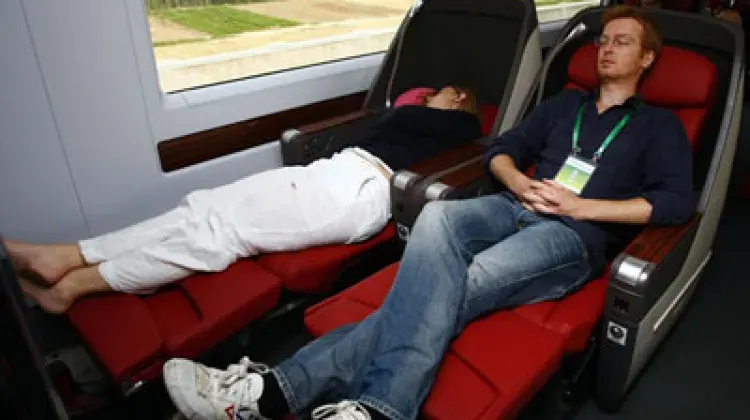
Business-class Seat (Source from TopChinaTravel)
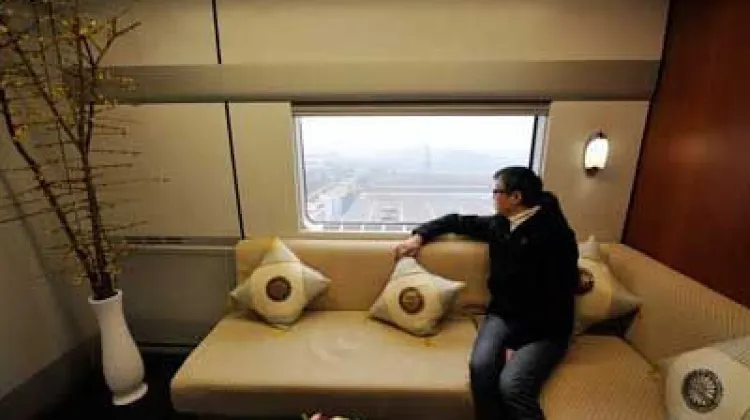
Deluxe Soft Sleeper (Source from TopChinaTravel)
💖If you're curious about how to buy China train tickets, check the following articles to learn more:
How to Choose China Speed Train Ticket Seats
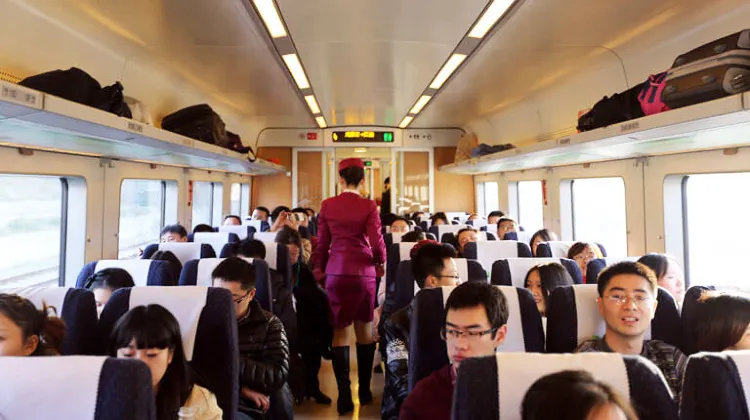
Second Class Seat Carriage Environment (Source from China Discovery)
- G trains, which travel at speeds between 250 km/h and 400 km/h, drastically cut travel times, such as reducing the Beijing to Shanghai journey from 6 hours to just 4 hours over a distance of 1318 km. Introduced in 2017, Fuxing trains can reach speeds of up to 400 km/h on this route.
- D trains, running at speeds between 200 km/h and 250 km/h, are typically slower and stop at more stations, making them a more affordable option for travelers covering various routes.
Here’s a table showing the seating options on China's high-speed train tickets👇
| Seat Type | Train Type | Comfort Level | Features |
| Second Class | G, D, C | Standard | Adjustable backrest, ample legroom, tray table, hooks for bags, power outlets, most economical. |
| First Class | G, D, C | High | Wider seats, more legroom, adjustable backrest and footrest, pillow, larger tray table, extra power outlets. |
| Business Class | G, some D, C | Premium | Spacious seating, fully reclining seats, privacy features, complimentary meals and beverages, enhanced entertainment. |
| New Sleepers | Overnight D | High | Parallel alignment to carriage, privacy curtains, essential amenities within reach, private compartments. |
| Soft Sleepers | Overnight D | High | Four bunks per compartment, sliding door for privacy, standard sleeper amenities. |
| Deluxe Soft Sleepers | Overnight D | Deluxe | Two bunks per compartment, private bathroom, luxury amenities, most private and comfortable option. |
Both G and D trains, along with C trains, provide various seating arrangements to meet different comfort preferences and travel needs.
✅If you're curious about how to stay connected in China, check out the following packages!
China Train Ticket: 1st Class VS. 2nd Class
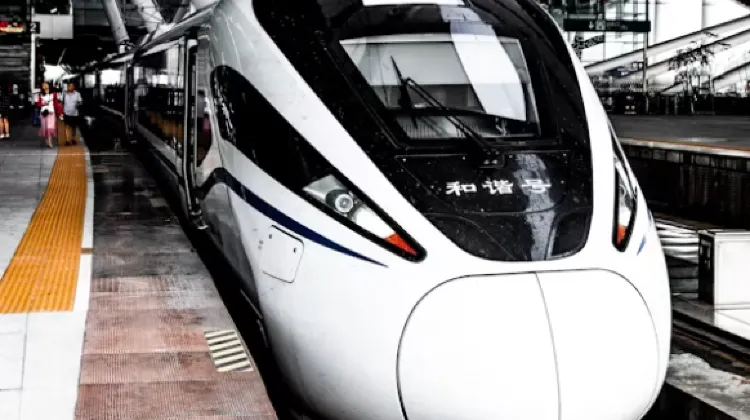
Source from Unsplash
First class and second class seats are the most popular choices on China's high-speed train tickets, each catering to different preferences.
If you prioritize comfort, often travel for business, or need more space, first class seats are ideal. They're also a good fallback when second class seats are sold out. On the other hand, for those looking to save money or traveling in groups, second class seats are recommended for their affordability and comfort, akin to airplane economy class.
From my own experience, I recommend second class tickets because they are much cheaper, and the difference in amenities is minor. The comfort level is sufficient for me to comfortably spend four to five hours on the train, making it a practical choice for journeys of this duration.
Seat Arrangement
First Class seats on G, C, and D trains are generally wider than those in Second Class, measuring about 48 cm compared to 45 cm. Additionally, First Class offers more space between rows, enhancing legroom and overall comfort. The seats in First Class also recline more, from 5 to 32 degrees, providing better relaxation options compared to the 5 to 24-degree recline in Second Class. If onboard comfort is a priority, the spacious and comfortable First Class seats are certainly the better choice.
First Class carriages have fewer seats, typically 28, with four seats per row (two on each side), offering a less crowded and quieter environment. This setting is ideal for business travelers or those who prefer a restful journey, with minimal noise and fewer disturbances. On the other hand, Second Class carriages accommodate over 70 seats arranged in a 3+2 format per row. This can feel more cramped, especially for larger passengers, and is often noisier due to the presence of families and children.
| Category | First Class | Second Class |
| Seat Arrangement | 2+2 | 3+2 |
| Number of Seats per Carriage | 28 | > 70 |
| Seat Width | 47 cm (19 inches) | 42 cm (17 inches) |
| Leg Room | 40-50 cm (16-20 inches) | 40 cm (16 inches) |
| Aisle Width | 60 cm (24 inches) | 45 cm (18 inches) |
【Note】
Despite the narrower seats and space in Second Class, it is still more spacious than airplane economy seats, making it a viable option for those accustomed to air travel. This, coupled with its cheap price, makes Second Class a practical choice for budget-conscious travelers or those on shorter trips.
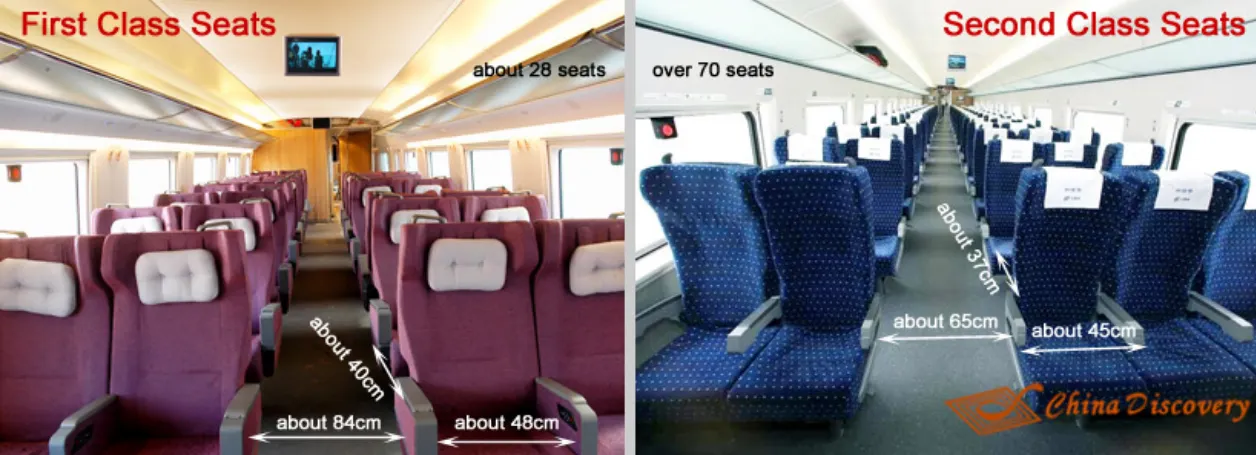
Source from China Discovery
Seat Table
- First Class Carriage Tables: The foldable tables are located within the armrest, usually on the passenger’s right side. These tables are larger and can be extended across to the width of the seat, offering greater convenience and space.
- Second Class Carriage Tables: The tables are attached to the back of the seat in front. These are smaller compared to those in the first class and may pose a limitation. For instance, if passengers rotate their seats to face each other, they cannot use these tables effectively.
- Seat Rotation: Both first and second class seats are rotatable, which allows passengers to choose to face the direction of travel or to face each other.
【Note】
In first class, passengers who choose to sit facing each other can still use the foldable tables. However, this is not the case in second class, where the design of the foldable tables restricts their use when seats are facing each other.
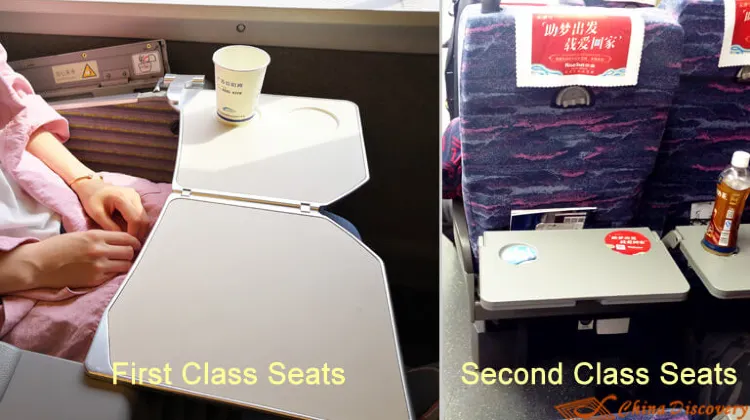
Source from China Discovery
Other Facilities
First class seats on high-speed trains offer superior comfort with both hard and soft footrests under each seat and soft pillows at the headrest for neck support. In contrast, second class seats do not provide these amenities.
Additionally, power sockets are more accessible in first class, available on both sides of every row, while in second class, sockets are limited to either side of the row.
| Facility | First Class | Second Class |
| Footrest | Available under each seat, both hard and soft types | Not available |
| Pillow | Soft pillows attached at the headrest for neck support | Not available |
| Power Sockets | Available on both sides of every row | Available on either side of the row, limited |
How to Book China Train Ticket Online
Trip.com is an international online travel agency that provides 24/7 customer service in various languages catering international travelers, including English, France, Japanese, etc. It also accepts various payment methods including international credit cards, Paypal, AliPay and Wechat Pay. Buy cheap China train tickets to explore China ASAP!
| Step | Process |
| 1 | Log in to Trip.com. Select your departure city, destination, and time. For unlisted cities, manually enter the city name. |
| 2 | Choose a seat class (second class, first class, or business class) and click "Book" to continue. |
| 3 | Fill in passenger and contact information including name, email, and phone number. |
| 4 | Select your seat preference (window, aisle, or middle) among A, B, C, D, F seats, then click "Book" to proceed to payment. |
| 5 | Choose a payment method (credit/debit card, PayPal, Pay Later, WeChat Pay, Alipay) to complete the purchase. |
12306 vs. Trip.com
When booking train tickets in China, travelers can choose between 12306, the official site of China Railway Corporation, and Trip.com, a reliable international travel agency. While 12306 allows users to book directly, it often experiences technical issues and offers support only in Chinese during limited hours. Conversely, Trip.com provides a user-friendly interface, multilingual 24/7 customer support, and accepts various payment methods, making it cheaper and more accessible for international travelers.
| Feature | 12306 | Trip.com |
| Booking Source | Official China Railway website | Best International travel agency |
| Additional Fees | No extra fees | Possible extra fees |
| Service Hours | 5 AM to 1 AM (11:30 PM on Thursdays) | 24/7 |
| Website Reliability | Occasional errors and crashes | Stable and user-friendly |
| Customer Service | Chinese only, limited hours | Multilingual, available 24/7 |
| Payment Options | Limited to local methods | International credit cards, AliPay, WeChat Pay |
| Additional Services | None | Hotels, flights, tours |
FAQs about China Train Ticket
How do foreigners buy train tickets in China?
Foreigners can purchase train tickets in China through several methods including railway stations or ticket outlets, calling the official hotline at 95105105, visiting the official China Railway Corporation website at 12306.cn, or using online platforms like Trip.com and its mobile app. A tip to remember is that long lines are common at railway stations and ticket outlets.Is train travel cheap in China?
Train travel in China is affordable, fast, and reliable. It's also a more environmentally friendly option compared to flying. Additionally, most major cities in China are well-connected by high-speed rail.How much is a train ticket in China?
The cost of train tickets in China varies widely depending on the distance and the type of seat. Prices can start from as low as CNY 20 (approximately USD 3) for a short journey in a basic seat and can increase significantly for longer distances or more premium seating options.When to buy China train tickets?
It's best to purchase train tickets in China as early as possible, especially during peak travel times like Chinese New Year, national holidays, and summer vacation periods. Tickets typically go on sale 30 days in advance for online and telephone bookings and 28 days in advance at ticket counters. To secure your preferred travel dates and times, buying tickets right when they become available is advisable.


 NO.1
NO.1












